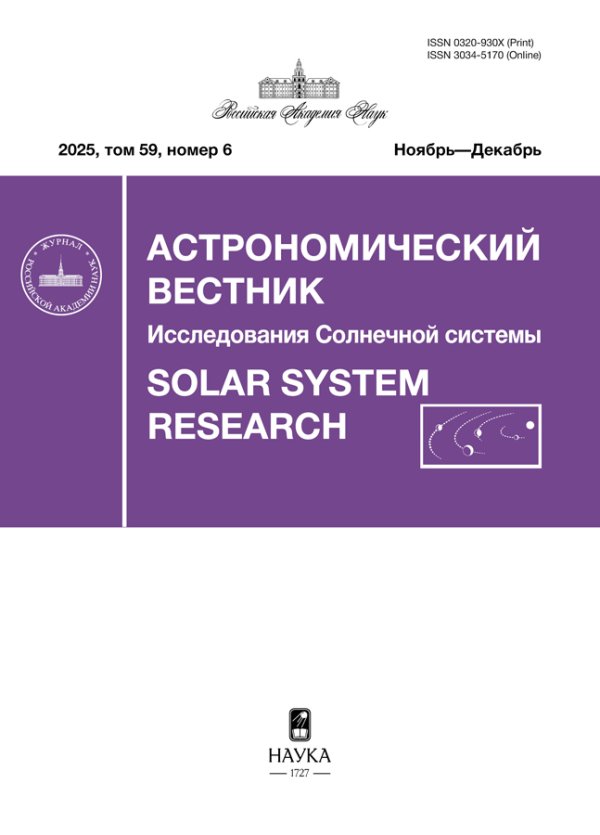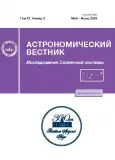Vol 57, No 3 (2023)
Articles
Estimation of the Neutron Component of the Radiation Background in the Gale Crater on Mars
Abstract
The paper presents the results of the analysis of the neutron component of the radiation background on Mars in the Gale crater, where the NASA Curiosity rover conducts its research. Numerical estimates have shown that the effective dose rate for neutrons at the maximum flux of galactic cosmic rays varies along the rover path by 20% in the range of 92–108 μSv/day. This variation is mainly driven by the variable content of subsurface water, which ranges from 0.5 to 5% mass fraction along the rover path. The estimates obtained are comparable with the measurements of the RAD radiation dosimeter. The comparison with doses from charged particles shows that the contribution of the neutron component on the surface of Mars to the total dose with no radiation protection is 10%, which should be taken into account when planning manned missions to Mars.
 199-208
199-208


O2 (а1Δg) Airglow at 1.27 μM and upper Mesosphere Dynamics on the Night Side of Venus
Abstract
This research studies the O2 (a1 Δg) nightglow distribution in 1.27 μm to understand the dynamics of the atmosphere of Venus. Several factors were considered in the retrieval process, such as thermal emission of the lower atmosphere, reflection by the clouds. Results show deviation from SS-AS circulation mode: the area where horizontal flows from the dayside converge and where oxygen recombines and emits shifts from the midnight to 22–23 hours local time. This shift is caused by solar-induced thermal tide on Venus nightside. Some conclusions about the upper mesosphere dynamics are also presented.
 209-224
209-224


On the Kinetic Features of Sedimentation of Dust Particles in the Martian Atmosphere
Abstract
The mode of subsidence of layered structures in the ionosphere of Mars has been studied taking into account the compositional features of the Martian atmosphere. The characteristic sedimentation rates of dust particles, their sizes and charges, as well as the sedimentation time of layered structures are calculated. The results obtained can be used in the study of atmospheric phenomena on Mars in the course of upcoming space missions.
 225-231
225-231


Searching for Life on Venus: History of the Problem and Basic Concepts
Abstract
Venus has always been one of the priorities of the space research program in Russia. The history of successful investigations of Venus in the Soviet Union is primarily associated with delivering a whole series of spacecraft to it and implementing the first ever landing on its surface. In the last few years, the study of Venus in astrobiological direction has been rapidly developing. To date, a fairly large number of theoretical papers have been published, the main purpose of which is to estimate the possibility of the existence of living organisms on Venus. The most likely ecosystem, in which Earth-type organisms could develop, is considered to be a dense cloud layer of Venus. It is supposed that, in this layer, hypothetical microbial communities could exist in aerosols being a concentrated aqueous solution of sulfuric acid. Microorganisms in such a specific air habitat are to be exposed to several extreme factors at once, the main among which are very low values of pH and water activity. The principal strategies for survival under these conditions should be the availability of effective biochemical mechanisms of resistance to the impact of adverse environmental factors and the use of all possible ways of extracting energy in such an ecosystem to maintain the biomass of organisms at a level for stable reproduction.
 232-247
232-247


Stable Orbits in the Feeding Zone of the Planet Proxima Centauri c
Abstract
Estimates of the size of the feeding zone of the planet Proxima Centauri c have been made at initial orbital eccentricities of planetesimals equal to 0.02 or 0.15. The research is based on the results of modeling of the evolution of planetesimals’ orbits under the influence of the star and planets Proxima Centauri c and b. The considered time interval reached a billion years. It was found that after the accumulation of the planet Proxima Centauri c some planetesimals may have continued to move in stable elliptical orbits within its feeding zone, largely cleared of planetesimals. Usually such planetesimals can move in some resonances with the planet (Proxima Centauri c), for example, in the resonances 1 : 1 (as Jupiter Trojans), 5 : 4 and 3 : 4 and usually have small eccentricities. Some planetesimals that moved for a long time (1–2 million years) along chaotic orbits fell into the resonances 5 : 2 and 3 : 10 with the planet Proxima Centauri c and moved in them for at least tens of millions of years.
 248-261
248-261


Jeans Instability of an Astrophysical Self-Gravitating Medium in the Presence of High Radiation Pressure and Diffuse Radiative Transfer
Abstract
Within the problem of modeling the evolution of a protostellar disk, a discussion is presented on the effect of radiation on the Jeans gravitational instability for a self-gravitating optically thick (for intrinsic infrared radiation) gas-and-dust medium, taking into account the influence of radiation pressure perturbations and radiative diffusion transfer on the critical wavelength. Two radiative diffusion approximations are considered: the case of perfect thermal equilibrium with the same temperature of matter and radiation and the case of the time dependence of the radiation field with an energy separation between radiation and matter. An analysis of the normal regime of modes is used to derive dispersion relations, which enable the derivation of modifications of the classical Jeans instability criterion under the influence of radiation pressure and radiation diffusion. In particular, it is shown that, in contrast to the system’s local thermodynamic equilibrium, where the acoustic velocity of perturbed gas propagates with the isothermal speed of sound, in the case of different temperatures of radiation and gas, the perturbing wave propagates with the adiabatic speed of sound in gas. The results obtained are aimed at solving the problem of gravitational instability of individual massive protostellar disks or self-gravitating radiative media characterized by large optical depths for their dust-transformed intrinsic infrared radiation.
 262-274
262-274


Fall to Earth of Fragments of Destroyed Asteroid
Abstract
The effect of the destruction of asteroids in orbits as they approach the Earth, and the consequences of their impacts, have been estimated. The areas affected by a shock wave, a seismic wave, and radiation upon impact of stony asteroids on land or upon entry into the atmosphere over land at a speed of 20 km/s are determined for a range of their sizes of 20–500 m. It has been found that arbitrary destruction of an asteroid near the Earth can lead to an increase in the total area affected by shock waves and thermal radiation during impacts of individual fragments. In the general case, reduction of damage after the destruction of asteroids with diameters of 150–500 m can be achieved if the bulk of the fragments are bodies with dimensions of less than 20–30 m, which do not pose a catastrophic danger.
 275-283
275-283


New Spectrometer ULTIMAN for Space Plasma Research
Abstract
Measurements of ion velocity distributions are one of basic goals of space plasma studies. There is variety of ion and electron spectrometers (see, for example, Wüest et al., 2007; Young et al., 2007; Zurbuchen and Gershman, 2016; Vaisberg et al., 2016). The most commonly used ion spectrometer is the top-hat analyzer (Carlson et al., 1983) consisting of a toroidal electrostatic analyzer, an electrostatic scanner, and a timeof-flight section with thin foil as a start element and ion preacceleration. We describe a new energy-mass analyzer with an electrostatic scanner providing a hemispheric field of view with small aberration, a toroidal electrostatic analyzer, and a time-of-flight synchronizer with a simple gate. It provides desirable hemisphere scanning, wide energy range, and reasonable mass resolution to meet most space exploration challenges. It can provide detailed measurements of the ion velocity distribution of ion species without significant gaps to obtain the structure of the hot plasma flow. With simple electrooptics elements this analyzer can be easily modified for many plasma research purposes.
 284-292
284-292












